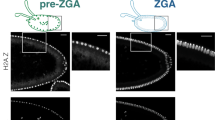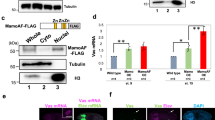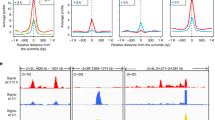Abstract
In all animals, the initial events of embryogenesis are controlled by maternal gene products that are deposited into the developing oocyte. At some point after fertilization, control of embryogenesis is transferred to the zygotic genome in a process called the maternal-to-zygotic transition. During this time, many maternal RNAs are degraded and transcription of zygotic RNAs ensues1. There is a long-standing question as to which factors regulate these events. The recent findings that microRNAs2,3 and Smaug4 mediate maternal transcript degradation have shed new light on this aspect of the problem. However, the transcription factor(s) that activate the zygotic genome remain elusive. The discovery that many of the early transcribed genes in Drosophila share a cis-regulatory heptamer motif, CAGGTAG and related sequences5,6, collectively referred to as TAGteam sites5 raised the possibility that a dedicated transcription factor could interact with these sites to activate transcription. Here we report that the zinc-finger protein Zelda (Zld; Zinc-finger early Drosophila activator) binds specifically to these sites and is capable of activating transcription in transient transfection assays. Mutant embryos lacking zld are defective in cellular blastoderm formation, and fail to activate many genes essential for cellularization, sex determination and pattern formation. Global expression profiling confirmed that Zld has an important role in the activation of the early zygotic genome and suggests that Zld may also regulate maternal RNA degradation during the maternal-to-zygotic transition.
This is a preview of subscription content, access via your institution
Access options
Subscribe to this journal
Receive 51 print issues and online access
$199.00 per year
only $3.90 per issue
Buy this article
- Purchase on Springer Link
- Instant access to full article PDF
Prices may be subject to local taxes which are calculated during checkout




Similar content being viewed by others
Accession codes
Primary accessions
Gene Expression Omnibus
Data deposits
The microarray data have been deposited in NCBI’s Gene Expression Omnibus (GEO; http://www.ncbi.nlm.nih.gov/geo/) and are accessible through GEO series accession number GSE11231.
References
Newport, J. & Kirschner, M. A major developmental transition in early Xenopus embryos: II. Control of the onset of transcription. Cell 30, 687–696 (1982)
Giraldez, A. J. et al. Zebrafish miR-430 promotes deadenylation and clearance of maternal mRNAs. Science 312, 75–79 (2006)
Bushati, N., Stark, A., Brennecke, J. & Cohen, S. Temporal reciprocity of miRNAs and their targets during the maternal-to-zygotic transition in Drosophila . Curr. Biol. 18, 501–506 (2008)
Tadros, W. et al. SMAUG is a major regulator of maternal mRNA destabilization in Drosophila and its translation is activated by the PAN GU kinase. Dev. Cell 12, 143–155 (2007)
ten Bosch, J. R., Benavides, J. A. & Cline, T. W. The TAGteam DNA motif controls the timing of Drosophila pre-blastoderm transcription. Development 133, 1967–1977 (2006)
De Renzis, S. D., Elemento, O., Tavazoie, S. & Wieschaus, E. F. Unmasking activation of the zygotic genome using chromosomal deletions in the Drosophila embryo. PLoS Biol. 5, 1036–1051 (2007)
Li, X. et al. Transcription factors bind thousands of active and inactive regions in the Drosophila blastoderm. PLoS Biol. 6, 365–388 (2008)
Jiang, J., Rushlow, C. A., Zhou, Q., Small, S. & Levine, M. Individual Dorsal morphogen binding sites mediate activation and repression in the Drosophila embryo. EMBO J. 11, 3147–3154 (1992)
Kirov, N., Zhelnin, L., Shah, J. & Rushlow, C. Conversion of a silencer into an enhancer: evidence for a co-repressor in dorsal-mediated repression in Drosophila . EMBO J. 12, 3193–3199 (1993)
Staudt, N., Fellert, S., Chung, H., Jäckle, H. & Vorbrüggen, G. Mutations of the Drosophila zinc finger-encoding gene vielfältig impair mitotic cell divisions and cause improper chromosome segregation. Mol. Biol. Cell 17, 2356–2365 (2006)
Bourbon, H. M. et al. A P-insertion screen identifying novel X-linked essential genes in Drosophila . Mech. Dev. 110, 71–83 (2002)
Simpson, L. & Wieschaus, E. F. Zygotic activity of the nullo locus is required to stabilize the actin-myosin network during cellularizatiron in Drosophila . Development 110, 851–863 (1990)
Schweisguth, F., Lepesant, J. A. & Vincent, A. The serendipity alpha gene encodes a membrane-associated protein required for the cellularization of the Drosophila embryo. Genes Dev. 4, 922–931 (1990)
Lecuit, T., Samanta, R. & Wieschaus, E. slam encodes a developmental regulator of polarized membrane growth during cleavage of the Drosophila embryo. Dev. Cell 2, 425–436 (2002)
Stein, J. A., Broihier, H. T., Moor, L. A. & Lehmann, R. Slow as molasses is required for polarized membrane growth and germ cell migration in Drosophila . Development 129, 3925–3934 (2002)
Grosshans, J., Müller, H. & Wieschaus, E. Control of cleavage cycles in Drosophila embryos by frühstart . Dev. Cell 5, 285–294 (2003)
Robinson, D. N. & Cooley, L. Examination of the function of two kelch proteins generated by stop codon suppression. Development 124, 1405–1417 (1997)
Stathopoulos, A. & Levine, M. Genomic regulatory networks and animal development. Dev. Cell 9, 449–462 (2005)
Markstein, M., Markstein, P., Markstein, V. & Levine, M. S. Genome-wide analysis of clustered Dorsal binding sites identifies putative target genes in the Drosophila embryo. Proc. Natl Acad. Sci. USA 99, 763–768 (2002)
Gross, S. P., Guo, Y., Martinez, J. E. & Welte, M. A. A determinant for directionality of organelle transport in Drosophila embryos. Curr. Biol. 13, 1660–1668 (2003)
Pilot, F., Philippe, J. M., Lemmers, C., Chauvin, J. P. & Lecuit, T. Developmental control of nuclear morphogenesis and anchoring by charleston, identified in a functional genomic screen of Drosophila cellularization. Development 133, 711–723 (2006)
Biemar, F. et al. Spatial regulation of microRNA gene expression in the Drosophila embryo. Proc. Natl Acad. Sci. USA 102, 15907–15911 (2005)
Gunsalus, K. C. et al. Predictive models of molecular machines involved in Caenorhabditis elegans early embryogenesis. Nature 436, 861–865 (2005)
Ryder, E. et al. The DrosDel collection: a set of P-element insertions for generating custom chromosomal aberrations in Drosophila melanogaster . Genetics 167, 797–813 (2004)
Chou, T. B., Noll, E. & Perrimon, N. Autosomal P[ovoD1] dominant female-sterile insertions in Drosophila and their use in generating germ-line chimeras. Development 119, 1359–1369 (1993)
Chou, T. B. & Perrimon, N. The autosomal FLP-DFS technique for generating germline mosaics in Drosophila melanogaster . Genetics 144, 1673–1679 (1996)
Yu, Y. et al. The nuclear hormone receptor Ftz-F1 is a cofactor for the Drosophila homeodomain protein. Nature 385, 552–555 (1997)
Kirkpatrick, H., Johnson, K. & Laughon, A. Repression of dpp targets by binding of brinker to mad sites. J. Biol. Chem. 276, 18216–18222 (2001)
Acknowledgements
We thank the following people for gifts of RNA probes, plasmids, antibodies and fly stocks: J. Erickson, R. Lehmann, R. Cinalli, R. Martinho, C. Navarro, J. Treisman and L. Pick. We thank J. Rhee and A. Chung for help with isolating and characterizing zld null mutants, and S. Fu for help locating TAGteam sites in Zelda target genes. We are grateful to M. Siegel and K. Birnbaum for help with the microarray analysis, and C. Desplan, P. Struffi, S. Small and R. Lehmann for critical reading of the manuscript. This work was supported by a grant from the National Institutes of Health (GM63024).
Author information
Authors and Affiliations
Corresponding author
Supplementary information
Supplementary Information
This file contains Supplementary Methods, Supplementary Figures S1 and S2 with Legends, Supplementary Tables S1 and S2 and Supplementary References. (PDF 1462 kb)
Rights and permissions
About this article
Cite this article
Liang, HL., Nien, CY., Liu, HY. et al. The zinc-finger protein Zelda is a key activator of the early zygotic genome in Drosophila. Nature 456, 400–403 (2008). https://doi.org/10.1038/nature07388
Received:
Accepted:
Published:
Issue Date:
DOI: https://doi.org/10.1038/nature07388
This article is cited by
-
KLF4 facilitates chromatin accessibility remodeling in porcine early embryos
Science China Life Sciences (2024)
-
Sleeping embryonic genomes are awoken by OBOX proteins
Nature (2023)
-
OBOX regulates mouse zygotic genome activation and early development
Nature (2023)
-
Stepwise modifications of transcriptional hubs link pioneer factor activity to a burst of transcription
Nature Communications (2023)
-
Proteomics and Phosphoproteomic Analysis to Identify Spleen of Takifugu rubripes Infected Cryptocaryon irritans
Marine Biotechnology (2023)
Comments
By submitting a comment you agree to abide by our Terms and Community Guidelines. If you find something abusive or that does not comply with our terms or guidelines please flag it as inappropriate.



